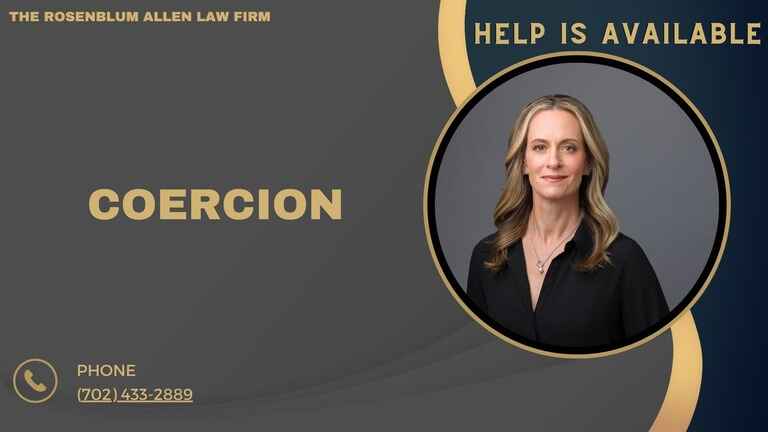Definition of Coercion
Coercion is a complex concept that involves forcing someone to act in a certain way through pressure, threats, or intimidation. It often strips away the individual’s free will, making them comply with demands they would not typically agree to. Understanding coercion is important, as it can manifest in various aspects of life, including personal relationships, workplaces, and even legal settings.

 Understanding the Basic Concept of Coercion
Understanding the Basic Concept of Coercion
At its core, coercion undermines a person’s autonomy. Instead of making voluntary choices, the coerced individual feels compelled to act against their will. This pressure can take many forms, whether subtle or overt.
Distinguishing Coercion from Related Concepts
It’s important to differentiate coercion from similar concepts like persuasion and manipulation:
- Persuasion involves convincing someone to see things your way through reason and argument.
- Manipulation often entails deceptive tactics to influence someone’s decisions but doesn’t always involve direct threats.
Understanding these distinctions helps clarify how coercion operates in real-life scenarios.
The Psychological and Emotional Aspects of Coercion
Coercion can have lasting psychological effects on individuals. Victims may experience feelings of fear, anxiety, and helplessness. Understanding these emotional responses is vital for recognizing the impact of coercive behavior on mental health.
Types of Coercion
Coercion can be categorized into several types, each with distinct characteristics and implications.
Physical Coercion
Defining Physical Coercion and Its Implications
Physical coercion involves the use of force or the threat of force to compel someone to act. This can include everything from physical violence to the threat of harm.
Examples of Physical Coercion in Various Contexts
- Domestic Violence: A partner may use threats of physical harm to control the other.
- Robbery: A thief may threaten violence to steal from a victim.
- Kidnapping: Forcing someone into a situation against their will through physical means.
Psychological Coercion
Defining Psychological Coercion and Its Impact
Psychological coercion uses mental and emotional pressure rather than physical threats. This form can be more subtle but equally damaging.
Examples of Psychological Coercion in Personal Relationships and Workplaces
- Gaslighting: Manipulating someone into doubting their reality.
- Emotional Blackmail: Threatening to withdraw love or support unless the victim complies.
- Intimidation: Using fear tactics to control behavior, such as a boss making veiled threats about job security.
Economic Coercion
Understanding Economic Coercion and Its Manifestations
Economic coercion occurs when financial pressures are used to control someone’s actions. This can involve exploiting someone’s financial dependency.
Examples of Economic Coercion in Employer-Employee Relationships
- Wage Theft: An employer withholding wages to force employees to comply with unreasonable demands.
- Threatening Job Loss: A manager may threaten to fire an employee unless they agree to unjust terms.
Legal Coercion
Defining Legal Coercion in the Context of the Law
Legal coercion involves using legal threats to influence behavior, often through intimidation or the abuse of power.
Examples of Legal Coercion and Its Effects on Individuals
- Threatening Lawsuits: Using the threat of legal action to manipulate behavior.
- Abuse of Legal Authority: Law enforcement or government officials applying pressure to achieve compliance.

The Legal Framework Surrounding Coercion
Understanding the legal implications of coercion is essential for both victims and those accused of coercive behavior.
Overview of Laws Related to Coercion
Many jurisdictions have laws addressing coercive practices. These laws aim to protect individuals from being forced into compliance through threats or violence.
State and Federal Laws Addressing Coercive Actions
In the United States, both state and federal laws cover aspects of coercion, including:
- Assault and Battery: Laws against physical coercion.
- Harassment Laws: Regulations protecting individuals from psychological coercion.
- Employment Laws: Protections against economic coercion in the workplace.
This legal framework helps establish the boundaries of acceptable behavior and provides avenues for victims to seek justice.
Elements of Coercion in Legal Context
To establish coercion in a legal sense, certain elements must be proven. Understanding these is vital for anyone involved in a coercion-related case.
Understanding the Legal Definitions and Standards of Proof
The legal definitions of coercion vary, but generally include:
- Threat or Force: There must be a clear threat of harm or actual physical force.
- Intent: The person using coercion must intend to compel another’s behavior.
- Resulting Action: The victim must act (or refrain from acting) as a result of the coercion.
The Role of Intent and Harm in Establishing Coercion
Intent plays a critical role in determining whether an act is coercive. If someone uses threats without intending to harm but still causes distress, the situation may still qualify as coercive.
Coercion in Various Contexts
Coercion can occur in many areas of life. Each context brings its own unique challenges and implications. Understanding how coercion manifests in these settings is important for recognizing and addressing it effectively.
Coercion in Personal Relationships
Coercion often appears in intimate relationships. It can create an unhealthy dynamic that affects both partners.
Understanding How Coercion Manifests in Intimate Relationships
In personal relationships, coercion may be more subtle than outright violence. It can take many forms, including emotional manipulation or threats.
Signs of Coercive Behavior and Its Impact on Individuals
Some common signs of coercion in personal relationships include:
- Constant Monitoring: One partner excessively checks on the other’s whereabouts.
- Isolation: A partner discourages relationships with friends or family.
- Fear of Reactions: The victim feels anxious about how their partner will respond to certain actions.
The impact of coercion can be profound. Victims may experience:
- Low Self-Esteem: Constant control can diminish confidence.
- Anxiety and Depression: Living under pressure can lead to mental health struggles.
- Difficulty Trusting: Coercion can make it hard to form new relationships.
Coercion in the Workplace
Coercion can also happen in professional environments. It can significantly affect employees and workplace dynamics.
Identifying Coercive Practices in Professional Settings
In the workplace, coercive behavior may manifest through threats, manipulation, or unfair demands.
Legal Protections Against Workplace Coercion
Various laws protect employees from coercive practices. These protections include:
- Whistleblower Laws: Protecting employees who report illegal activities.
- Employment Contracts: Ensuring fair treatment and outlining rights.
- Labor Laws: Safeguarding against unfair treatment or harassment.
Coercion in Law Enforcement
Law enforcement agencies have significant power. This power can sometimes lead to coercive tactics that undermine justice.
Exploring Coercive Tactics Used in Law Enforcement
Coercion in law enforcement can take several forms:
- Threats of Arrest: Using the threat of arrest to extract confessions or information.
- Intimidation: Officers may intimidate individuals to gain compliance.
- Misuse of Authority: Overstepping legal boundaries to coerce actions.
Legal Standards Governing Police Conduct
To combat coercive tactics, there are legal standards in place:
- Due Process: Protects individuals from unlawful coercion or interrogation.
- Civil Rights Laws: Ensures that individuals are treated fairly and justly.
- Accountability Measures: Systems to address complaints against law enforcement behavior.

Recognizing and Addressing Coercion
Recognizing coercion is the first step toward addressing it. Understanding the signs and knowing what to do can empower individuals.
Signs of Coercion
Recognizing the signs of coercion is essential for anyone involved in a situation that feels manipulative or controlling. Some key indicators include:
- Fearful Reactions: Individuals feel scared about how they will be treated.
- Constant Anxiety: A lingering sense of worry about compliance.
- Changes in Behavior: The victim may act differently due to fear of repercussions.
Common Signs That Indicate Coercive Behavior
Additional signs to watch for include:
- Withdrawal from Activities: Avoiding social events or activities once enjoyed.
- Frequent Apologies: Constantly saying sorry, even for minor issues.
- Justification of Behavior: The victim rationalizes the abuser’s actions.
Immediate Actions to Protect Yourself
If you find yourself in a coercive situation, here are some steps you can take:
- Document Everything: Keep a record of incidents and behaviors.
- Reach Out for Support: Talk to trusted friends, family, or professionals.
- Establish Boundaries: Communicate your limits clearly and firmly.
Seeking Legal Help and Support Resources
Victims of coercion should know their rights and options. Various resources are available, including:
- Legal Aid Organizations: Providing free or low-cost legal services.
- Counseling Services: Helping individuals navigate the emotional impact of coercion.
- Support Groups: Connecting with others who have similar experiences.
Legal Remedies for Coercion
Understanding the legal options available can empower victims to take action.
Understanding the Legal Options Available to Victims
Victims can explore several legal avenues, such as:
- Filing a Restraining Order: Legal protection against an abuser.
- Pursuing Criminal Charges: Holding perpetrators accountable for their actions.
- Civil Suits: Seeking compensation for damages suffered due to coercive behavior.
Filing Complaints and Pursuing Legal Action
Taking legal action can be a daunting process, but it’s important to know how to navigate it:
- Consult an Attorney: Seek legal advice to understand your options.
- Gather Evidence: Compile documentation to support your case.
- File Within Time Limits: Be aware of deadlines for filing claims.

Preventing Coercion
Preventing coercion involves raising awareness and promoting healthy relationships. Education plays a vital role in this effort.
Education and Awareness
Knowledge is power. Educating individuals about coercion can help prevent it from occurring in the first place.
The Importance of Educating Individuals About Coercion
Educational initiatives can provide valuable information about recognizing and addressing coercive behavior. This can include:
- Workshops: Offering practical skills for recognizing and responding to coercion.
- Online Resources: Providing information about coercion and how to seek help.
- Community Events: Promoting discussions about healthy relationships and consent.
Resources for Learning More About Coercive Behavior
Several resources are available for further education on coercion:
- Books and Articles: Numerous publications discuss coercion in depth.
- Online Courses: Many platforms offer courses on recognizing and preventing coercion.
- Support Organizations: Groups dedicated to helping victims understand their rights.
Building Healthy Relationships
Creating environments where coercion is less likely to occur is essential. Healthy relationships are built on mutual respect and understanding.
Promoting Communication and Mutual Respect to Prevent Coercion
Encouraging open communication can help foster trust. Key strategies include:
- Active Listening: Ensuring both partners feel heard and understood.
- Establishing Boundaries: Clearly communicating personal limits.
- Respecting Autonomy: Valuing each person’s right to make independent choices.
Strategies for Fostering Healthy Dynamics in Personal and Professional Relationships
To build and maintain healthy relationships, consider the following strategies:
- Encourage Collaboration: Work together to solve problems instead of dominating discussions.
- Promote Transparency: Be open about feelings and expectations.
- Practice Empathy: Understanding each other’s perspectives can strengthen bonds.

Breaking It Down for You
Coercion is a complex issue that affects many aspects of life. Understanding its forms and implications is essential for fostering healthy relationships. Knowledge empowers individuals to recognize coercion and take action against it.
Summary of Key Points on Coercion
In this article, we explored various aspects of coercion, including:
- Definitions and Types: Coercion can manifest in personal relationships, workplaces, and law enforcement.
- Signs and Impact: Recognizing signs of coercion helps individuals understand its effects on mental health and well-being.
- Legal Protections: Laws exist to protect victims from coercive behavior, providing avenues for seeking justice.
- Prevention: Education and awareness are vital in preventing coercion and promoting healthy dynamics.
Encouragement for Action Against Coercion
It’s important to speak up against coercion. Whether you are a victim or a bystander, your voice matters. If you see signs of coercion, don’t hesitate to act. Reach out to someone you trust or a professional who can help.
Resources for Further Information
Having access to reliable resources can make a difference in understanding and addressing coercion.
Helpful Organizations and Websites
Here are some organizations that provide support and information:
- National Domestic Violence Hotline: Offers resources and support for individuals facing coercion and abuse. (1-800-799-SAFE)
- RAINN (Rape, Abuse & Incest National Network): Provides resources for survivors of sexual violence. (1-800-656-HOPE)
- Equal Employment Opportunity Commission (EEOC): Offers guidance on workplace coercion and discrimination.
- Mental Health America: Provides resources for mental health support related to coercive relationships.
Suggested Books and Articles
Consider exploring these books and articles for more insight:
- “Why Does He Do That?” by Lundy Bancroft: A deep dive into abusive relationships and how coercion plays a role.
- “The Verbally Abusive Relationship” by Patricia Evans: Discusses emotional abuse and its coercive aspects.
- Articles on Coercion: Websites like Psychology Today and the American Psychological Association feature articles on recognizing and addressing coercion.
Hotlines for Immediate Support
If you or someone you know is in immediate danger or needs urgent support, consider reaching out to these hotlines:
- National Domestic Violence Hotline: 1-800-799-SAFE (7233)
- Crisis Text Line: Text “HELLO” to 741741 for 24/7 support.
- Local Shelters and Support Services: Check community resources for immediate assistance.
Final Thoughts on Coercion
Awareness and education about coercion are powerful tools in combatting its effects. By understanding what coercion looks like, we can all play a role in preventing it. Let’s create a culture of respect and support, ensuring that everyone has the right to live free from coercion and manipulation.

Frequently Asked Questions
What is the difference between coercion and persuasion?
Coercion involves forcing someone to act against their will through threats or pressure, while persuasion relies on convincing someone through reasoning or argument without pressure.
Can coercion happen in professional environments?
Yes, coercion can occur in workplaces, where individuals may be pressured to conform to certain behaviors or decisions through threats of job loss or negative evaluations.
How can I identify if I am being coerced?
Look for signs such as feeling pressured to make decisions, being threatened with negative consequences, or experiencing a lack of control over your choices.
Is there a statute of limitations on coercion claims?
Yes, the statute of limitations varies by jurisdiction and the specific circumstances of the case. It’s important to consult with a legal professional to understand the timelines applicable to your situation.
Can coercion occur in non-violent relationships?
Absolutely. Coercion can be emotional or psychological, not just physical. It may involve manipulation, intimidation, or other forms of pressure to control someone’s actions.
What should I do if I witness someone being coerced?
If you see someone being coerced, it’s important to offer your support. Encourage them to seek help, and if safe to do so, intervene by discussing the situation with them or reporting it to authorities.
Are there any support groups for victims of coercion?
Yes, many organizations offer support groups for individuals who have experienced coercion or abuse. Local shelters, community centers, or online resources can help connect you with supportive networks.
Can therapy help someone recover from the effects of coercion?
Yes, therapy can be very beneficial for individuals recovering from coercion. Mental health professionals can provide coping strategies, support, and tools to rebuild confidence and autonomy.
What are some long-term effects of coercion on individuals?
Long-term effects can include anxiety, depression, low self-esteem, difficulty trusting others, and challenges in forming healthy relationships.
How can I protect myself from being coerced?
Educating yourself about your rights, setting clear boundaries, and seeking support from trusted friends or professionals can help protect you from coercive situations.
Is coercion illegal?
Yes, coercion is illegal in many contexts, especially when it involves threats or manipulation that infringe on an individual’s rights. Legal recourse may be available for those affected.
Can coercive behavior occur in friendships?
Yes, coercive behavior can happen in friendships as well. It may manifest as manipulation or pressure to conform to certain expectations or actions.
What resources are available for educating others about coercion?
Many organizations provide educational materials, workshops, and seminars on coercion and its effects. Websites like RAINN or local domestic violence shelters often offer these resources.
If I am uncertain whether I am being coerced, what steps should I take?
Trust your instincts. If something feels off, consider talking to a trusted friend or a professional who can help you evaluate the situation and provide guidance.

Additional Resources for You
Molly Rosenblum, Esq., our distinguished lead attorney, has meticulously developed a range of specialized resources to support and guide those facing criminal charges. These resources, available on the Rosenblum Law website, are designed to provide in-depth insights, legal advice, and support for a variety of criminal defense matters. Here’s a brief overview of each resource, tailored to assist you in navigating through challenging times:
Criminal Defense Attorneys: An extensive resource for those seeking defense against criminal charges, offering insights into strategies and legal representation. Explore the resource.
Las Vegas DUI Lawyer: Dedicated guidance for DUI (Driving Under the Influence) charges in Las Vegas, including legal strategies and defense mechanisms. Learn more.
Domestic Violence Lawyer Las Vegas: Specialized support for individuals facing domestic violence charges, offering defense strategies and legal advice. Discover the details.
Drug Possession Lawyer: Expert legal assistance for drug possession charges, with a focus on defense tactics and mitigating penalties. Begin your defense.
Sex Crimes Attorney: Specialized representation and advice for those accused of sex crimes, focusing on defense strategies and privacy protection. Understand your options.
CPS Defense Attorney: Guidance for cases involving Child Protective Services (CPS), including child abuse and neglect accusations. Learn about CPS defense.
Misdemeanor Lawyer: Legal support for misdemeanor charges, offering strategies to minimize penalties and impact on one’s life. Explore misdemeanor defense.
Juvenile Defense Lawyers: Dedicated defense services for minors facing criminal charges, focusing on protecting the future of young individuals. Get juvenile defense help.
Las Vegas Warrant Defense Attorney: Assistance with warrant issues in Las Vegas, including strategies to address and resolve outstanding warrants. Address warrant concerns.
Las Vegas Probation Violation Attorney: Expert legal advice for handling probation violations, aimed at reducing consequences and advocating for rights. Understand probation violation defense.
Theft Crime Defense Lawyer: Defense strategies and legal assistance for those accused of theft, focusing on reducing charges and penalties. Learn about theft defense.
Kidnapping Lawyers: Specialized legal support for kidnapping charges, offering defense strategies to challenge accusations and evidence. Discover kidnapping defense.
Firearms Lawyer Las Vegas: Legal guidance on charges related to firearms in Las Vegas, including unlawful possession and use. Explore firearms defense.
Through these resources, Molly Rosenblum, Esq., aims to empower you with the knowledge and legal support necessary to navigate the complexities of criminal defense. We encourage you to utilize these resources, ensuring you’re well-prepared and informed for any legal challenges you may face.

Offsite Resources for You
Here are seven offsite resources that could be useful to anyone seeking further information on legal matters:
American Bar Association: The ABA provides a wealth of resources for the public including information on finding legal help, understanding legal terms, and exploring various areas of law.
National Association of Criminal Defense Lawyers: This association shares resources pertaining to criminal defense including reports, legal education materials, and information on advocacy efforts.
Legal Information Institute – Cornell Law School: A comprehensive resource for U.S. law, offering the U.S. Constitution, Supreme Court cases, federal laws, and legal encyclopedia.
The Innocence Project: This organization is dedicated to exonerating wrongly convicted individuals through the use of DNA testing and to reforming the criminal justice system.
Justia: A platform for free case law, regulations, legal news, and a directory of lawyers and other legal professionals in the United States.
FindLaw: This site provides free legal information, a directory of lawyers, blogs, and various community forums.
The National Legal Aid & Defender Association (NLADA): NLADA is America’s oldest and largest nonprofit association devoted to excellence in the delivery of legal services to those who cannot afford counsel. They provide advocacy, guidance, information, and training.
Remember, while these resources can provide valuable information, they are not a substitute for personalized legal advice from a qualified attorney.

A Special Message from Our Lead Attorney

Molly Rosenblum
Dear Reader,
I am writing to express my sincere gratitude for exploring our resources related to coercion charges in Las Vegas. Navigating the legal landscape can be overwhelming and confusing, and I aim to ensure you have the information you need to make informed decisions about your situation.
Remember, while online resources are a great starting point, they cannot replace personalized advice tailored to your circumstances. Each case is unique, and it’s crucial to have experienced legal guidance to navigate the complexities of the legal system effectively.
I invite you to schedule a free consultation with our team to discuss your case and explore the best possible strategies for your defense. Please don’t hesitate to call us at (702) 433-2889. We are here to help, listen, and stand by your side during this challenging time.
Thank you once again for your time, and I look forward to the possibility of assisting you.
Warm Regards,
Molly Rosenblum, Esq


